
The latest rumours surrounding AMD's upcoming Vega GPUs point towards GTX 1070- or 1080-class performance. This means the GTX 1080 Ti will likely remain the best choice in the upper echelons of the consumer graphics card market. KitGuru has already assessed a wide range of GTX 1080 Tis and the PNY XLR8 OC Gaming is another overclocked and custom-cooled solution for the serious gamer to ponder.

PNY's interpretation of Nvidia's GTX 1080 Ti GPU is pure and simple, casting aside many of the advanced or unnecessary features, depending on your perspective, that have become common place on top-tier GPUs. The XLR8 OC Gaming's strategy is a dual slot and triple-fan cooling solution, a full-cover aluminium backplate and factory overclock.
That means, to clarify, there's no RGB lighting, no passive fan mode, no onboard fan headers, no BIOS switches, no customisable decals…you get the idea. This simplistic approach may find appeal among certain audiences, particularly those unimpressed by the RGB lighting “fad” or those not wanting to overload their motherboard with a monstrous triple-slot and air-cooled graphics card.
PNY's factory overclocks aren't particularly adventurous either; a boost clock of 1645 MHz is meagre for an overclocked SKU and the stock memory reflects PNY's conservative strategy with this product.
| GPU | Nvidia GTX 1080 Ti Founders Edition | PNY GTX 1080 Ti Blower Edition | PNY GTX 1080 Ti XLR8 OC Gaming |
| Base Clock |
1480 MHz | 1480 MHz | 1531 MHz |
| GPU Boost Clock | 1582 MHz | 1582 MHz | 1645 MHz |
| Memory Clock Effective |
11008MHz | 11008MHz | 11008MHz |
| Memory Bandwidth | 484 GB/s | 484 GB/s | 484 GB/s |
| Price (£) | £689 / $699 | £TBC / $740 | £TBC / $735 |
It's certainly not a graphics card to excite the senses or push the boundaries so PNY has to impress with cooling, noise and, most importantly, pricing.
PNY's packaging reflects the theme of simplicity inherent in the product's design. An XLR8 sticker, installation guide and DVI (Female) to Display Port (Male) make up the accessory bundle.
The PNY GTX 1080 Ti XLR8 OC Gaming is a sleek looking graphics card with its grey and black colour scheme that's enhanced with a highlight of red. The translucent fans add some more intrigue to the design. Perhaps the most interesting design characteristic of all is that PNY has managed to squeeze into a dual slot form factor in a market where most graphics card vendors have accepted the need for 3 slots to tame the GTX 1080 Ti's 250W plus TDP.
This graphics card is longer than other graphics cards in its class, presumably to accommodate some additional cooling capacity that is lost to the dual-slot form factor. The length of the cooling solution and backplate extends an inch or so beyond the terminus of the PCB. It measures in at 31 to 32cm long, depending on whether the I/O is included or not, and is 11 to 13cm high, with the same I/O caveat.
The weight is perhaps to most telling specification, just 1.05kg compared to 1.25kg for the MSI GTX 1080 Ti Gaming X, 1.34kg for the Palit GTX 1080 Ti JetStream and 1.75kg for the MSI GTX 1080 Ti Lightning Z. The shedding of 200g compared to its nearest rival suggests a thinner and lighter heat pipe and heat sink assembly.
Four large 8mm heat pipes terminate at the end of the card along with the 6 and 8 pin PCIe power connectors. The I/O sticks to one PCIe slot with three DisplayPort 1.4 and one HDMI 2.0b, it has an identical configuration and I/O mesh design to the Founders Edition card.
The heat sink assembly is a little light on fins compared to some other higher density graphics cards KitGuru has tested. The heat pipe arrangement consists of four 8mm and one 6mm for a total of five heat pipes. These all originate from a solid copper contact plate which is directly aligned to three thermal pads that draw heat away from the video memory.
An additional heat sink with associated thermal pads is affixed to the PCB to provide cooling to the power delivery components.
The full-cover backplate is made of aluminium and is fairly light, it includes cut-outs to ventilate the rear of the graphics card PCB.
As far as we can tell PNY's PCB design for the XLR8 OC is identical to the Nvidia Reference design board shipped with the Founders Edition. There are 7 phases with 14 dual-FETs for a total power capability of 250 amps.
Our GPU test system has been built with the intention of benchmarking a variety of graphics cards from mid-range to high-end. Each GPU is tested in a number of 3D applications and games at 1080p, 1440p and 2160p (“4K”) resolutions using Very High or Ultra detail presets.
Test System Components
- Case: Corsair 400Q (two stock case fans replaced with Noctua 120mm rear exhaust and 140mm front intake, speeds UEFI-limited)
- Processor: Intel Core i7-6700K (Stock Intel Turbo behaviour).
- Memory: 16GB (2x8GB) G.Skill Trident Z XMP (3200MHz 16-18-18-38 @ 1.35V).
- Graphics Card: Variable.
- System Drive: Samsung 850 EVO 512GB SSD
- CPU Cooler: Corsair H100i v2 (pump at 12 volts, fan speed UEFI-limited to reduce noise).
- Power Supply: Seasonic Platinum 760W.
- Operating System: Windows 10 Pro 64-bit.
General Test System Notes
- AMD Graphics cards were benchmarked with the AMD (Crimson ReLive Edition) 17.4.2 drivers (17.10.1711 Beta 5) except the RX 570 and RX 580 GPUs which were benchmarked with a special press release driver (17.10.1030 Beta 8).
- Nvidia Graphics cards were benchmarked with the Nvidia (GeForce Game Ready) 381.65 driver.
- To tune the test system appropriately for acoustic measurements the case was stripped of its original fans and fitted with ultra quiet Noctua fans.
- The CPU cooler, the Corsair H100i v2, was set to a fixed low fan speed to further reduce the base noise level while the pump was left to operate at full speed since it produces no significant noise output.
- The CPU was left to default Intel Turbo behaviour, disabling ASUS enhancements such as all-core Turbo to minimise heat output inside the case and non-GPU related power consumption. The CPU voltage was also negatively offset (read: reduced) by a measure of -0.15 to further reduce non-GPU related heat and power consumption and keep CPU temperatures down to accommodate for the ultra silent CPU and System fan profiles.
- Each 3D benchmark or game is run 3 times at each resolution with an average result of the three runs taken as the final result for the graphs. Where benchmark screenshots are shown note these may not match the graphed figure since the graph represents the average of three while the screenshot is a single of those three values.
Comparison Graphics Cards List
- AMD RX 480 8GB (1266MHz core, 8000MHz memory)
- ASUS GTX 1080 ROG Strix OC 11Gbps (1696MHz core, 1835MHz boost, 11008MHz memory)
- ASUS RX 570 STRIX Gaming OC 4GB (1300MHz core, 7000MHz memory)
- Gigabyte Aorus GTX 1080 Ti Xtreme Edition 11GB (1607MHz core, 1721MHz boost, 11232MHz memory)
- Gigabyte GTX 1080 G1 Gaming 8GB (1695MHz core, 1835MHz boost, 10010MHz memory)
- Gigabyte GTX 980 Ti Xtreme Gaming Windforce 6GB (1216MHz core, 1317MHz boost, 7200MHz memory)
- MSI GTX 1080 Gaming X Plus 8GB (1683MHz core, 1823MHz boost, 11008MHz memory)
- MSI GTX 1080 Ti Gaming X 11GB (1544MHz core, 1658MHz boost, 11008MHz memory)
- MSI GTX 1080 Ti Lightning Z (1582MHz core, 1695MHz boost, 11124MHz memory)
- MSI R9 390 8GB Gaming (1040MHz core, 6000MHz memory)
- Nvidia GTX 1060 6GB Founders Edition (1506MHz core, 1708MHz boost, 8008MHz memory)
- Nvidia GTX 1080 Ti Founders Edition 11GB (1480MHz core, 1582MHz boost, 11008MHz memory)
- Palit GTX 1080 Ti Super JetStream (1557MHz core, 1671MHz boost, 11008MHz memory)
- PNY GTX 1070 XLR8 Gaming OC 8GB (1607MHz core, 1797MHz boost, 8008MHz memory)
- PNY GTX 1080 Ti XLR8 OC Gaming 11GB (1531MHz core, 1645MHz boost, 11008MHz memory)
- Sapphire R9 Fury X 4GB (1050MHz core, 1000MHz memory [HBM])
- Sapphire RX 470 Nitro+ OC 4GB (1260MHz core, 7000MHz memory)
- Sapphire RX 580 Nitro+ Limited Edition 8GB (1450MHz core, 8000MHz memory)
- Zotac GTX 970 4GB (1076MHz core, 1216MHz boost, 7010MHz memory)
Software and Games List
- 3DMark
- Ashes of the Singularity
- Deus Ex: Mankind Divided
- Furmark
- GPU-Z
- Grand Theft Auto V
- Metro Last Light Redux
- MSI Afterburner
- Rise of the Tomb Raider
- Steam
- SteamVR Performance Test
- Unigine Heaven
3DMark is a showcase DirectX 11 benchmark designed for today’s high-performance gaming PCs. It is our [FutureMark’s] most ambitious and technical benchmark ever, featuring real-time graphics rendered with detail and complexity far beyond what is found in other benchmarks and games today.
We run 3DMark Fire Strike (1080p), Fire Strike Extreme (1440p) and Fire Strike Ultra (4K).

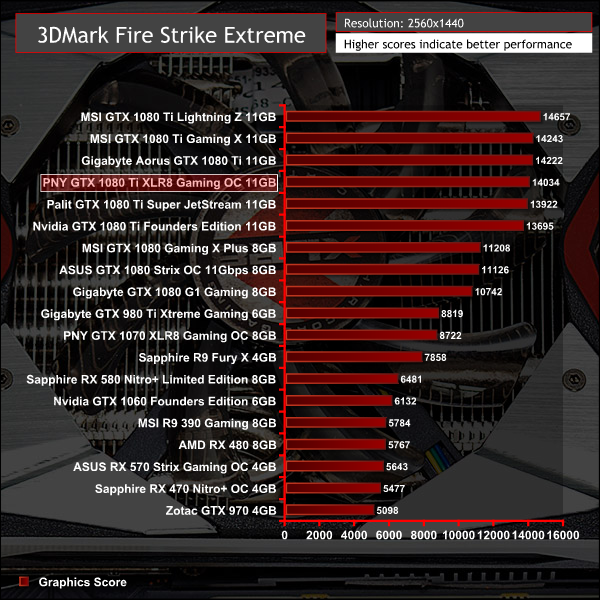

Performance in 3DMark reflected the PNY card's fairly average overclock.
The SteamVR Performance Test measures a system's rendering power using a 2-minute sequence from Valves Aperture Robot Repair VR demo. After collecting the data it determines whether a system is capable of running VR content at 90fps and whether VR content can tune the visual fidelity up to the recommended level. For machines that are not VR Ready the tool can help determine whether capabilities are bound by Graphics Card, CPU, or both.


Like other GTX 1080 Tis the PNY card is an excellent VR performer.
Unigine provides an interesting way to test hardware. It can be easily adapted to various projects due to its elaborated software design and flexible toolset. A lot of their customers claim that they have never seen such extremely-effective code, which is so easy to understand.
Heaven Benchmark is a DirectX 11 GPU benchmark based on advanced Unigine engine from Unigine Corp. It reveals the enchanting magic of floating islands with a tiny village hidden in the cloudy skies. Interactive mode provides emerging experience of exploring the intricate world of steampunk. Efficient and well-architected framework makes Unigine highly scalable:
- Multiple API (DirectX 9 / DirectX 10 / DirectX 11 / OpenGL) render
- Cross-platform: MS Windows (XP, Vista, Windows 7) / Linux
- Full support of 32bit and 64bit systems
- Multicore CPU support
- Little / big endian support (ready for game consoles)
- Powerful C++ API
- Comprehensive performance profiling system
- Flexible XML-based data structures
We set Quality to ‘Ultra’, Tessellation to ‘disabled’ and Anti-Aliasing to 2x.



No surprises in Unigine, PNY's solution is operating around 5 per cent faster than the Founders Edition.
Ashes of the Singularity is a real-time strategy game set in the future where descendants of humans (called Post- Humans) and a powerful artificial intelligence (called the Substrate) fight a war for control of a resource known as Turinium.
Players will engage in massive-scale land/air battles by commanding entire armies of their own design. Each game takes place on one area of a planet, with each player starting with a home base (known as a Nexus) and a single construction unit.
We opt for the Extreme quality profile and run the GPU-Focused test using the DX12 game mode.
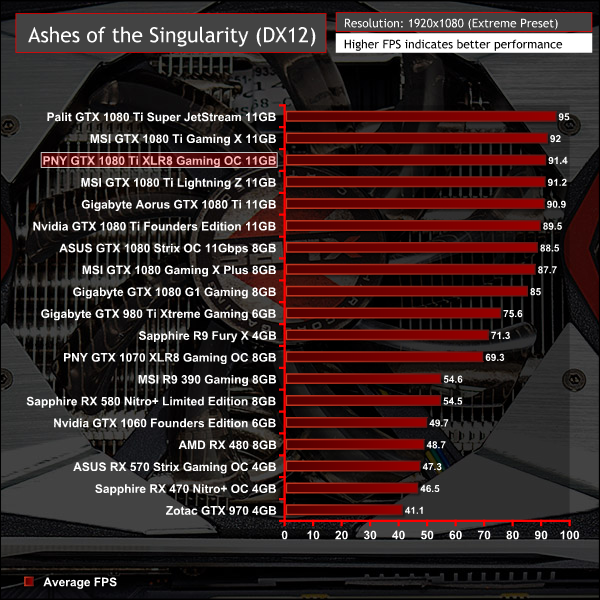


The PNY card seemed to struggle in Ashes of the Singularity. We're not sure if this reflects a thermal or power limitation or the increasing inconsistency of this game to benchmarking after a number of Steam updates.
Deus Ex: Mankind Divided is set in the year 2029, two years after the events of Human Revolution and the “Aug Incident”—an event in which mechanically augmented humans became uncontrollable and lethally violent.
Unbeknownst to the public, the affected augmented received implanted technology designed to control them by the shadowy Illuminati, which is abused by a rogue member of the group to discredit augmentations completely. (Wikipedia).
We test using the Ultra quality preset and the DirectX 12 API at all resolutions.



Again the PNY card is operating with about a 5 per cent lead of the Founders Edition.
Grand Theft Auto V is an action-adventure game played from either a first-person or third-person view. Players complete missions—linear scenarios with set objectives—to progress through the story. Outside of missions, players may freely roam the open world.
Composed of the San Andreas open countryside area and the fictional city of Los Santos, the world is much larger in area than earlier entries in the series. It may be fully explored after the game’s beginning without restriction, although story progress unlocks more gameplay content.
We use the Ultra quality settings (or the highest alternative when Ultra is unavailable), MSAA is set to 2x. The Advanced Graphics options are all set to their maximum levels. Memory usage is calculated as 3469, 3764 and 4733 at 1080, 1440p and 4K, respectively.



Grand Theft Auto V shows very little movement between GTX 1080 Ti GPUs.
Just like the original game Metro 2033, Metro: Last Light is played from the perspective of Artyom, the player-character. The story takes place in post-apocalyptic Moscow, mostly inside the metro system, but occasionally missions bring the player above ground. Metro: Last Light takes place one year after the events of Metro 2033, following the canonical ending in which Artyom chose to proceed with the missile strike against the Dark Ones (this happens regardless of your actions in the first game). Redux adds all the DLC and graphical improvements.
At all resolutions we test using a Very High quality profile with SSAA enabled and Tessellation set to Normal.



Metro Last Light scales neatly and so the PNY card falls slightly behind the Palit card which is clocked marginally higher. Full details on the clock speed configurations of all benchmarked GPUs is available on the Testing Methodology page.
Rise of the Tomb Raider is a third-person action-adventure game that features similar gameplay found in 2013’s Tomb Raider. Players control Lara Croft through various environments, battling enemies, and completing puzzle platforming sections, while using improvised weapons and gadgets in order to progress through the story. It uses a Direct X 12 capable engine.
We use the Very High quality preset and 2x SSAA at all resolutions with Direct X 12 enabled.



Another game and another consistent result.
Our acoustic measurements are less precise on this mid-range test system, the noise floor of the totally quiet testing room is 34 dBA as measured with a Benetech GM1351 Digital Sound Level Meter.
We take our measurements with the decibel meter on the top and middle section of the case, overhanging the side panel (PSU side, not Motherboard tray side) by exactly 1 inch to avoid any airflow pressure coming from the exhausting H100i V2.
The underlying noise level of the system, emitted by all the non-GPU hardware combined, is 35 dBa thus anything above this level can be attributed to the graphics cards. The PSU is passive for the entire power output range we tested all graphics cards in and all CPU and System fans have a fixed fan speed completely isolating them from any changes in temperature across the system.
Noise levels were measured after 5 minutes of load under three scenario: Furmark, Unigine Heaven and desktop idle in sequential order with 2 minutes downtime in between each test.

Noise levels were a little disappointing. There was only a slight discernible improvement in noise levels compared to the Founder's Edition, caused by a different pitch, but the total noise pressure output (dBA) was identical.
Fan speeds were as follows: 39% at idle (1300~ RPM) and 68% under sustained load (2250 RPM). The lack of a semi-passive fan mode means that the fans do not turn off at idle, resulting in slightly more idle noise but lower temperatures as a result.
Temperatures were measured after 5 minutes of load under three scenario: Furmark, Unigine Heaven and desktop idle in sequential order with 2 minutes of downtime in between each test. GPU-Z was used to record the maximum temperature, fan profiles on GPUs were left to their default behaviour.
Delta temperatures are presented below to account for small fluctuations in room temperature, but for all the testing present in this graph the temperature ranged from 21.6 to 23.1 degrees Celsius.



Temperatures were a marked improvement over the Founders Edition shaving off nearly 10 degrees Celsius at best, 7 degrees Celsius at worst. However, these temperatures were the worst of all non-reference GTX 1080 Tis on test reflecting the cards slimmed down heat sink assembly.
Users should note I test inside a PC Chassis (Corsair 400Q) and all non-GPU fans spin very slowly to isolate GPU noise and cooling performance. As such these results do tend towards a “worst case” scenario for cooling but all graphics cards on test receive the same treatment so results are comparable.
Hotspot results for the PNY card were very good and we didn't witness any significant spikes other than the top facing heat pipes which heated up exactly as they should.
Once we factored overclocking into the equation temperatures came within a degree or two of the throttling point of 84 degrees Celsius under heavy and prolonged load scenarios.
Power consumption was measured after 5 minutes of load under three scenario: Furmark, Unigine Heaven and desktop idle in sequential order with 2 minutes of downtime in between each test. The measurement was taking using an Energenie ENER007 power meter and measured for the whole system at the power supply, excluding the monitor.
While Furmark and desktop idle provide stable and consistent power read-outs, Unigine Heaven does not so the power reading is taken as the peak value that occurs in Scene 2 of 26.

Power consumption was typical of a GTX 1080 Ti of this frequency. PNY's factory overclock increases the card's TDP by about 20-watts over the Founders Edition.
Overclocking was in-line with current expectations of Nvidia's 16nm Pascal silicon. KitGuru's testing achieved 1,621 MHz on the GPU core and 1,495 MHz on the GPU memory.
For reference other GTX 1080 Ti GPUs achieved the following:
- Gigabyte Aorus GTX 1080 Ti Xtreme Edition – 1,637MHz GPU, 1,500MHz memory
- MSI GTX 1080 Ti Gaming X – 1,604MHz GPU, 1,478MHz memory
- MSI GTX 1080 Ti Lightning Z – 1,622MHz GPU, 1,565MHz memory
- Nvidia GTX 1080 Ti Founders Edition – 1,631MHz GPU, 1,426MHz memory
- Palit GTX 1080 Ti Super JetStream – 1,657MHz GPU, 1,476MHz memory

The final achieved overclock equated to a 7.5 per cent boost in performance.
PNY's GTX 1080 Ti XLR8 OC Gaming is probably the most conservative interpretation of Nvidia's GTX 1080 Ti to undergo KitGuru testing. PNY has taken the Founders Edition card, swapped the cooling assembly and embedded a mild factory overclock into the vBIOS.
The end result is that the PNY GTX 1080 Ti XLR8 runs cooler and faster than the Founders Edition card with similar levels of noise based on our testing. The PCB design and I/O haven't changed but PNY's addition of a backplate and an improved cooling solution make this card a definite upgrade on the Founders Edition, providing there is no specific requirement for the rear-exhaust blower cooling system.

Pricing and availability will underpin whether or not a consumer decides to purchase this PNY graphics card. PNY need to keep pricing competitive; similar to that of Nvidia's Founders Edition model and below that of rival overclocked offerings that deliver more features. At the time of writing UK pricing and availability was impossible to come by while in North America PNY has tacked on a $35 premium over the Founders Edition which is reasonable enough all things considered. PNY provides a 3 year warranty with this graphics card.
The bottom line for PNY's XLR8 OC Gaming GTX 1080 Ti is that many of its rivals (at least those tested by KitGuru) are better in terms of cooling, features, noise and performance. PNY needs to keep pricing at the entry point of the market since the PNY XLR8 OC Gaming only really offers a tangible upgrade over the Founders Edition and blower-style GTX 1080 Tis.
Given that pricing remains an unknown at the current point in time due to mining-induced market volatility it is hard to make a concrete judgement. Our best advice would be that the PNY card should remain a price-sensitive “consideration” to prospective GTX 1080 Ti owners. However, when a GTX 1080 Ti already requires significant outlay (£670+) to purchase, what's another £50 to upgrade to highly-rated custom solution with excellent cooling and a rich feature set?
Pros
- Dual-slot form factor
- Full-cover Backplate
- Improved cooling and performance over Founders Edition
- 3 year warranty
Cons:
- Lacking features such as RGB lighting, BIOS switches, passive fan mode, etc.
- Struggles to keep up with the cooling, noise and performance of rival custom GTX 1080 Tis
- Hampered by lack of availability
KitGuru says: PNY's GTX 1080 Ti XLR8 OC Gaming is a no-frills custom-cooled graphics card that offers improved cooling and performance over the reference Founders Edition model.
 KitGuru KitGuru.net – Tech News | Hardware News | Hardware Reviews | IOS | Mobile | Gaming | Graphics Cards
KitGuru KitGuru.net – Tech News | Hardware News | Hardware Reviews | IOS | Mobile | Gaming | Graphics Cards





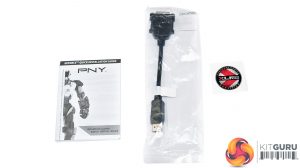


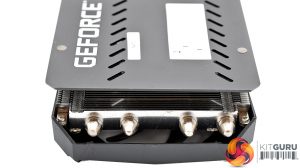
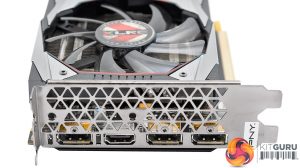
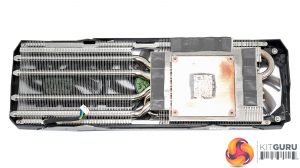




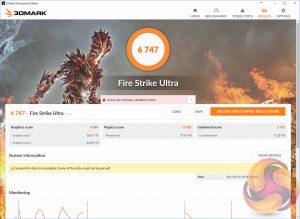






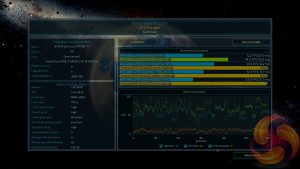









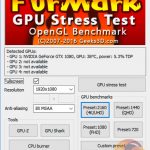




OMG now GPU cards must have RGB. LOL.
Channel64s
Blog74s
Gear130s